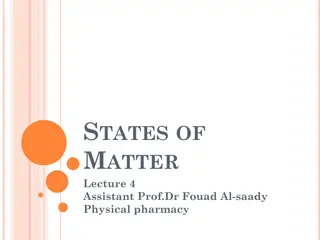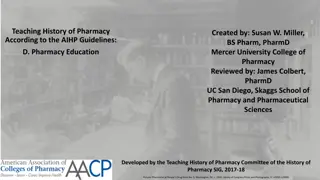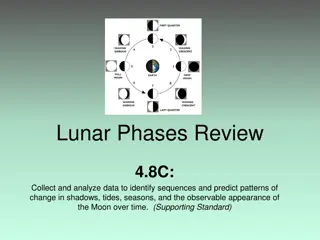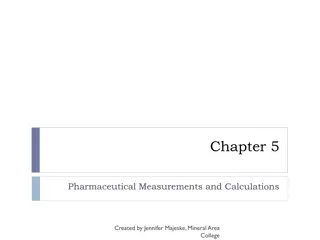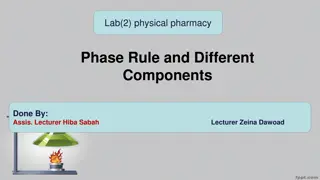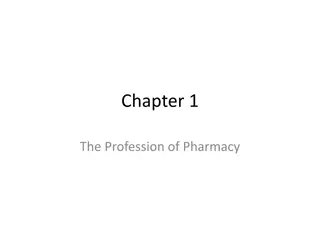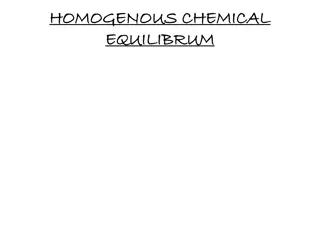Understanding the Phase Rule in Physical Pharmacy: Two Component Systems and Equilibrium Phases
The Phase Rule is essential in determining the state of a system based on components and phases. This study explores two-component systems in physical pharmacy, illustrating miscibility behaviors and equilibrium phases through diagrams and explanations. Understanding binodal curves, tie lines, and their role in defining phase regions provides key insights into system compositions and properties. Practical examples demonstrate how to analyze and calculate relative phase weights, highlighting the importance of temperature and concentration in phase equilibria studies.
Download Presentation

Please find below an Image/Link to download the presentation.
The content on the website is provided AS IS for your information and personal use only. It may not be sold, licensed, or shared on other websites without obtaining consent from the author. Download presentation by click this link. If you encounter any issues during the download, it is possible that the publisher has removed the file from their server.
E N D
Presentation Transcript
Lab(2) physical pharmacy the Phase Rule and Different Components Done By: Assis. Lecturer Hiba Sabah Lecturer Zeina Dawoad
phase rule : is a relationship for determining the least number of variables required to define the state of the system. -phase :-is homogeneous physically distinct portion of the system which is separated from other parts of the system by bounding surfaces (e.g. water & its vapor is one component two phase system) Number of component :is the smallest number of constituents by which the phase of equilibrium system can be expressed as a chemical formula or equation.
Two component systems containing liquid phase -as we know ethyl alcohol & water are miscible in all proportions , while water & mercury are completely immiscible regardless the amount of each. Between these two extremes lie a whole range of system which exhibit a partial miscibility ( or immiscibility) such as water & phenol , as their miscibility affected by two factors conc. & temp.
To see the effect of temp. & conc. ,we draw graph paper of temp. versus conc.
binodal curve :- is the curve that separates two phase area from one phase area . -tie line :- is the line drawn across the region of two phases (conjugate phases ) as each temp. has its own tie line. -upper consolute temp. or critical solu. Temp. :- is the maximum temp. at which two phase region exists . Water & phenol system it is 66.8 as all combinations above this temp. is completely miscible & give one phase system. -mass ratio:-is the relative amount by wt. of conjugate phase ,it depends on the position in tie line & temp. properties of the tie line in two component systems:- 1-it is parallel to the base line 2-all systems prepared along the tie line at equilibrium separated into two conjugate phases of constant composition.
For instance, consider a system containing 24% by weight of phenol and 76% by weight of water (point d in the diagram). At equilibrium two liquid phases have been presented in the tube. The upper one, A, has a composition of 11% phenol in water (point b on the diagram), whereas the lower layer, B, contains 11%--------24%----- 63% b-----------d------------c 63% phenol (point c on the diagram). The relative weights of the two phases can be calculated by the equation
advantages of binodal curve :- Binodal curve or phase diagram is used to formulate systems containing more than component in single liq. phase product Q: At 25 C a tie line 7%---------70% (w/w)% phenol in water, find the mass ratio and the composition of each phase of 40% w/w phenol by water at this temperature, note that the total weight is 10 gm? 7%-------40%------------70% b-----------d---------------c Wt of A =length dc 70-40 = 30 = 10 (mass ratio) Wt of B length bd 40-7 33 11 10+11=21 (total parts) 10 21 x 10 (total wt.) x= 4.76 gm wt of phase A(water rich layer) 10-4.76 = 5.24 gm wt of phase B (phenol rich layer) If we want to know the amount of phenol and water in each phase(composition) For phase A (water rich layer) 7 100 X 4.76 x= 0.33gm of phenol in A 4.76-0.33= 4.42 gm of water in A For phase B (phenol rich layer) 70 100 X 5.24 X= 3.6gm of phenol in B 5.24- 3.6= 1.57gm of water in B
Procedure: Prepare the following percent W/W phenol/water(10 gm total) 2%,7%,9%,11% ,24%,40%,55 %,63%,70%,75%. Put test tube in a fixed temperature in water bath (25 C0) or (left test tube at room temp.) and keep it for 10 minutes at that temp. Take the test tubes out and before their temp has changed record which one has 2 phases and which has one phase. Repeat the work at higher temp using the following temp.40C0, 50C0, 70C0. Draw a curve temp verses concentrations showing your 2 phases area and one phase area in the curve. Draw tie line for each temp. Take 40% W/W for example to find the mass ratio and the composition of each phase at different temp. Mention the upper consulate temp 2 gm 100 gm X 10gm X=0.2 gm of phenol 10-0.2=9.8gm water
The results of two components (phenol +water) Temp 2% 7% 9% 11% 24% 40% 55% 63% 70% 75% 25C 40C 50C 70C




